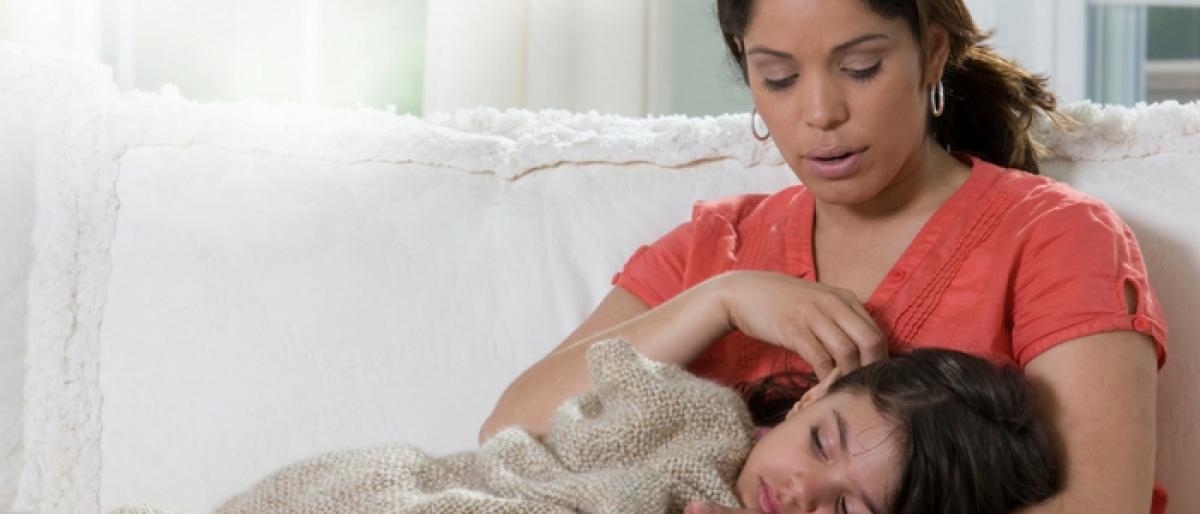Live
- PM Modi receives ceremonial welcome in Abuja, begins bilateral talks with Nigerian President Tinubu
- Goods traffic doubles on the new railway freight corridors
- BGT 2024-25: I’d like to see him make one more Test ton in Australia, says Johnso
- Harassment due to ED raids forced Kailash Gehlot to quit, hints Kejriwal
- Kailash Gehlot exit: BJP goes on the offensive against 'corrupt' AAP govt
- PM Modi pays homage to ‘the great’ Balasaheb Thackeray on his death anniversary
- One who cares for Delhi will not stay with gang of robbers: Sachdeva on Gahlot's resignation
- From Self-Doubt to Self-Love: Vange Cain’s Inspirational Path
- Rahul Gandhi remembers Balasaheb Thackeray on his death anniversary
- Tomato prices drop 22.5 pc as flow of fresh crop picks up pace
Just In

Growing kids are more vulnerable to infections as they are exposed to many new germs (viruses or bacteria) and their immune systems are still evolving to put up enough defenses against them.
Children fall prey to many infections and parents often do continual rounds of hospitals and clinics. Here’s a low down on infections common to children
Growing kids are more vulnerable to infections as they are exposed to many new germs (viruses or bacteria) and their immune systems are still evolving to put up enough defenses against them.
Most young children unto the age of 3-4 years will have 8-10 colds a year. Good news is that most of these infections are mild and resolve within few days. As the children get older, they fall sick less often.
The infants become more vulnerable towards infectious diseases after six months and it is highest at the age (3 years+), when they join pre-school or nursery. It happens as a direct consequence of their exposure with the outside world and chances of getting exposed to new germs. The infectious diseases that are most common in children are listed below:
Upper Respiratory Tract Infections
The most common occurring infectious diseases in children are upper respiratory tract infections. These are mostly viral infections but bacterial infections are also common. The upper respiratory tract includes the nose, mouth, sinuses and throat. The commonly included symptoms are cough, sore throat, runny nose, nasal congestion, headache, low grade or high grade fever and sneezing. Onset of symptoms usually begins 1–3 days after exposure.
Common upper respiratory tract infections include:
Common cold
Tonsillitis – infection of the tonsils
Pharyngitis -tissues at the back of the throat
Sinusitis – infection of the sinuses
Laryngitis – infection of the larynx (voice box)
Flu
The further complication in upper respiratory tract could also leads to ear infection. In this condition the ear is infected or clogged with fluid behind the ear drum and in few critical cases it needs a painful surgical procedure or tube insertion for curing it.
Since upper respiratory tract infection is highly contagious, therefore it is important to educate school going kids about few simple preventive precautions such as covering the nose while sneezing or coughing.
Mainstay of treatment includes general measures like temperature control, good hydration, warm saline gargles, use of decongestants and steam inhalation. Antibiotics are needed if the infections are caused by bacteria.
Lower Respiratory Tract Infections
The lower respiratory tract infections are also frequently recurring infections in kids. The infections affect the lungs and airways. In kids coughing is the most common symptom of this disease, which further gets aggravated with pain in chest and abdominal region. It can also lead to vomiting with cough. Kids also suffer from persistent fever, especially when the infection is bacterial instead of virus.
The common lower respiratory tract infections include:
Flu – which can affect either the upper or lower respiratory tract
Bronchitis – infection of the airways
Pneumonia – infection of the lungs
Pneumonitis - inflammation of the lungs
Bronchiolitis – an infection of the small airways that affects babies and children aged under two
The respiratory tract infection is highly contagious and become more common in winter. Viral induced wheeze is quite common in young children in winter, as the viral infection of the lower respiratory tract produce symptoms of wheeze and cough similar to asthma. Most of these conditions can be managed at home under proper medical guidance.
Gastrointestinal Infections
The most common symptoms: Gastroenteritis infections in children are diarrhea and vomiting. Many children have more than one incident of Diarrhea in a year. This infection could begin with a mildly upset tummy for a short period of time to a 2-3 days duration severe pain, vomiting and nausea in kids.
It can be managed at home initially but if the situation persists and shows the signs of dehydration it is important to consult the doctors. Babies and toddlers can become dehydrated more quickly than older children when they have diarrhea and vomiting. It's also important to be careful with hygiene by following certain simple steps such as hand wash and sanitization while your child is ill to stop diarrhea and vomiting spreading.
Seasonal Infections
Seasonal infection like Dengue, which mostly occurs in rainy season is also very common in children. Therefore if a child is having symptoms of Dengue like high grade fever, rash, pain behind the eyes and in the joints, muscles and/or bones, severe headache , abdominal pain etc, he /she needs to be consulted immediately with the doctor.
However, chikungunya, which is quite prevalent in rainy season, is not that infectious for kids, as compared to Dengue. General measures like temperature control and encouraging children to drink lots of fluids help prevent complications before seeking medical help. Common Infectious diseases in children can be prevented to certain extent with good hand hygiene, vector control and keeping the surroundings clean.
By: Dr Sreenath Manikanti
The writer is Consultant Neonatologist and Pediatrician, Fortis Hospitals.

© 2024 Hyderabad Media House Limited/The Hans India. All rights reserved. Powered by hocalwire.com







